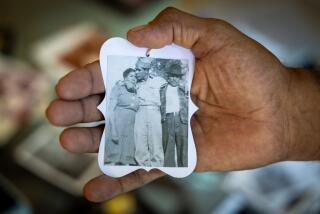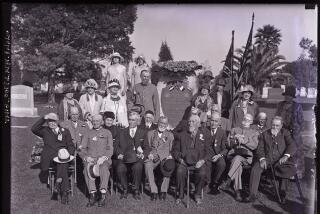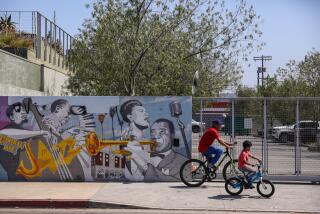Latinos Fight for Recognition : Veterans: San Gabriel Valley men are raising funds to build a memorial that will commemorate their wartime service.
Silviano Madrigal has no beef with the Army. When he got out of the service in 1952, in fact, Madrigal thought the Army had probably given him the best eight years, nine months and 27 days of his life. “It was one of the better homes I had,” he says.
No, the worst part of being a young Latino in era of lacerating intolerance came long before the Army, says Madrigal, 61, a brawny man with a gravelly laugh and arms like battering rams.
There was the segregated school system in La Puente, which relegated Latino kids like “Sil” Madrigal, the son of farm workers, to the “slow” school. (Absolutely true, says Hacienda La Puente Unified School District Superintendent James Johnson. The all-minority Central Elementary School stayed open in La Puente until 1945.)
There was Madrigal’s sudden separation at 16 from the city’s public school system, thanks to a La Puente High School administrator.
“One day he just called me into the office and sent me out to pick lemons,” says Madrigal, an instructor for Veterans in Community Service, a federally funded manpower program, who still lives in La Puente. “He said, ‘That’s what you’re going to be--a lemon picker,’ and he threw me out.”
And there was the sorry spectacle of the 1942 “zoot suit” riots, with mobs of white servicemen, spurred on by hatemongers and biased media reports, traveling to East Los Angeles to beat up young Latino pachucos. Some of the zoot suiters were themselves GIs on leave.
Madrigal, a proud zoot suiter himself in those days (“shark skins, English tie, Adams hat and triple-sole brogues,” he says, describing his outfit), laughs at the memory of it. “We hurt some of those sailors from the Midwest,” he says.
And then Madrigal went to war.
Young Latino men often have had to make a major leap of faith before they fought for their country. Called on to defend what many perceived as a far-from-perfect nation, the vast majority signed up. They may have paused a moment, Madrigal and other Latino veterans say, but then they leaped with alacrity.
“I don’t remember any Hispanics who didn’t want to go and do their duty for their country,” says Madrigal, who was awarded three Bronze Stars for valor in World War II and the Silver Star for heroism in Korea.
In fact, Latino servicemen’s contributions often were greater than those of any other group, say representatives of Latino veterans groups, who have begun raising funds for a Latino Veterans Memorial. One-fifth of the Latinos who served in Vietnam were killed in action, for example. One in three was wounded. On a per-capita basis, more Medals of Honor have been awarded to Latinos--37 of them--than to any other minority group.
Latino veterans may gloss over injustices they feel they have suffered in the United States. But the lack of acknowledgment of Latino war sacrifices is an indignity that many of them are not prepared to accept.
“Sure, the government is saying now that Hispanics were there,” says Gonzalez, head of the Assn. of Hispanic Vietnam Era Veterans, citing President Bush’s acknowledgment on Veterans Day that one-quarter of the names of casualties listed on a Texas Vietnam Veterans Memorial were Latino.
But the message isn’t getting to the most important audience--elementary and high school students of Latino heritage, says Gonzalez, a salesman for an El Monte printing company. “What we usually get is recognition in election campaign speeches and on holidays,” he says, “but it’s not filtering down to the level we’d like to see.”
The planned memorial--complete with the names of more than 20,000 Latino servicemen who have died in American wars since World War II--will serve as a focus for educational programs, says Gonzalez, whose group is leading the efforts to raise about $300,000 for the project. It’s expected to be unveiled in about two years at a San Gabriel Valley location that Gonzalez said he could not reveal.
In many ways, this is a do-it-yourself project, those who are involved say. “We’ve always had to initiate things like this,” says Ruben Treviso, a member of American GI Forum and public affairs director for Veterans In Community Service, based in Whittier. “We’re not bitter. We’re just going to build our own memorial.”
Put a group of Latino veterans together and the conversation seems to flow inevitably from battle stories to fallen friends to the gnawing issue of recognition.
“Look at all the John Wayne movies,” says Gonzalez. “Very few Hispanics. Once in a while, they dressed up Anthony Quinn or Cesar Romero as a soldier.” Recent movies about the Vietnam War, such as “Platoon” and “Full Metal Jacket,” have not been much better because they acknowledged Latino soldiers only in passing, he says.
This is a bitter pill for those who grew up in Latino communities during the 1960s and 1970s, says Treviso, who is from East Los Angeles. “All we saw in those days were hearses pulling into people’s driveways,” says Treviso, the holder of three Bronze Stars and a Vietnamese Cross of Gallantry from the South Vietnamese government. “All the kids we grew up with were coming home in coffins.”
The recognition issue can be highly personal for Latino veterans in the San Gabriel Valley. War service has become a pivotal life experience for many.
Art Cisneros, a Hacienda Heights resident who is deputy director of Veterans In Community Sarvice, remembers an East Los Angeles neighbor from his World War II-era childhood. “I was only about 12, and Alfonso Esparza used to come home from Camp Pendleton,” says Cisneros, a Korean War-era Air Force veteran. “I used to go over to his house, watch him polishing his boots, try on his hat. He died in Guadalcanal when I was 14. I remember the misery his family went through.”
For Madrigal, who grew up in crushing poverty, the military provided escape, self-esteem and, ultimately, disappointment.
He still relishes telling stories about his days in the Army. “Hey, suddenly I had sheets most of the time,” Madrigal recalls. “I didn’t have to try and buy surplus boots at the (Civilian Conservation Corps) camp. For the first time in my life, I was wearing underwear.”
An exuberant, brawling young man, Madrigal fought for respect in his 9th Infantry Division unit, he says. “I’d look for the meanest, toughest guy around, and we’d have to tangle so I could establish my credentials,” says Madrigal, who fought briefly as an Army welterweight contender.
He came home to California briefly as a civilian after World War II. “I said to myself, ‘I must be nuts,’ ” he says. “I’d been living high on the hog over in Europe, staying in plush hotels. I was somebody over there.” So he signed up again, just in time for Korea.
But the Korean War soured him on the military, he says. “There was no commitment to that war,” he says. “We had just beaten the two best armies in the world. Why were these guys kicking the hell out of us?”
In 1952, Madrigal was discharged and began raising a family. When his two sons were old enough for military service, Madrigal advised them against signing up. “I told them I didn’t want them getting involved in these penny-ante political situations (with the U.S. military),” he says.
Madrigal still tends to look at things from the worldly perspective of the frontline trenches. “We always caught the brunt of it,” he says of the Latino servicemen. “We were always called upon to do our bit. But I don’t think the government ever did its bit. The Latinos got shoved aside. That’s always been my feeling.”
More to Read
Sign up for Essential California
The most important California stories and recommendations in your inbox every morning.
You may occasionally receive promotional content from the Los Angeles Times.










